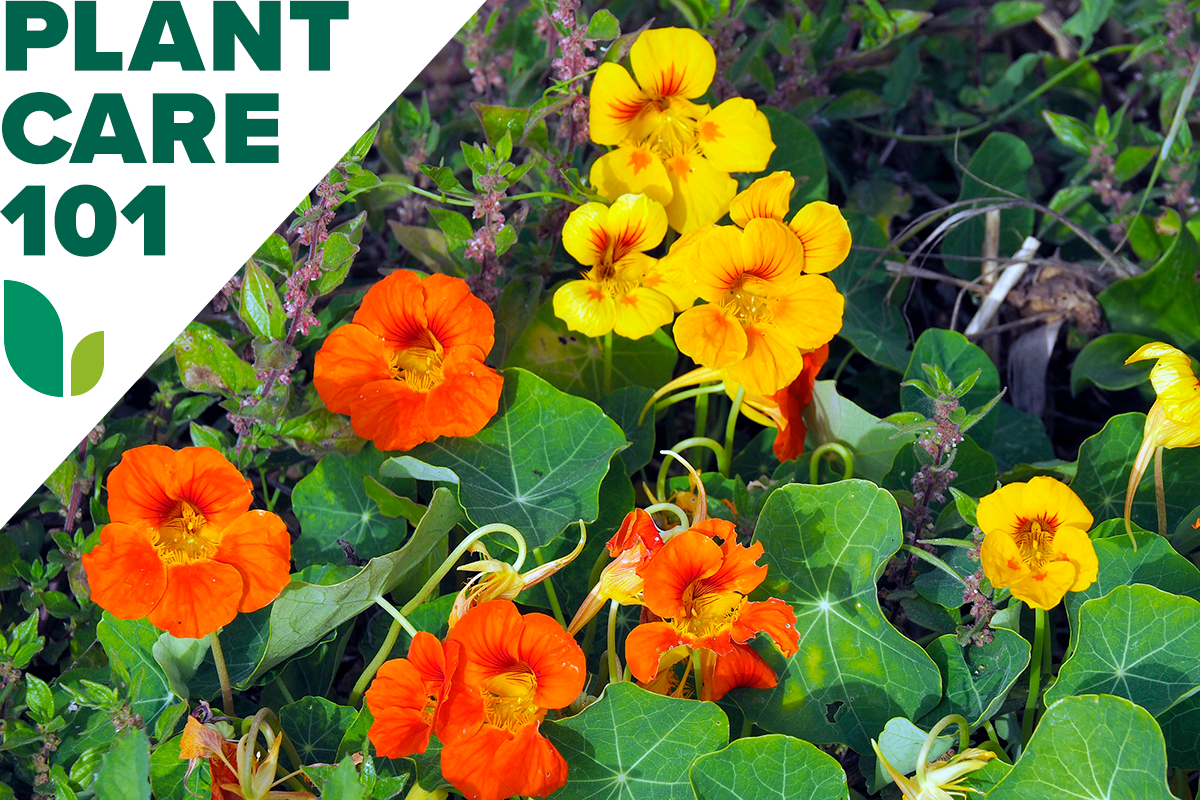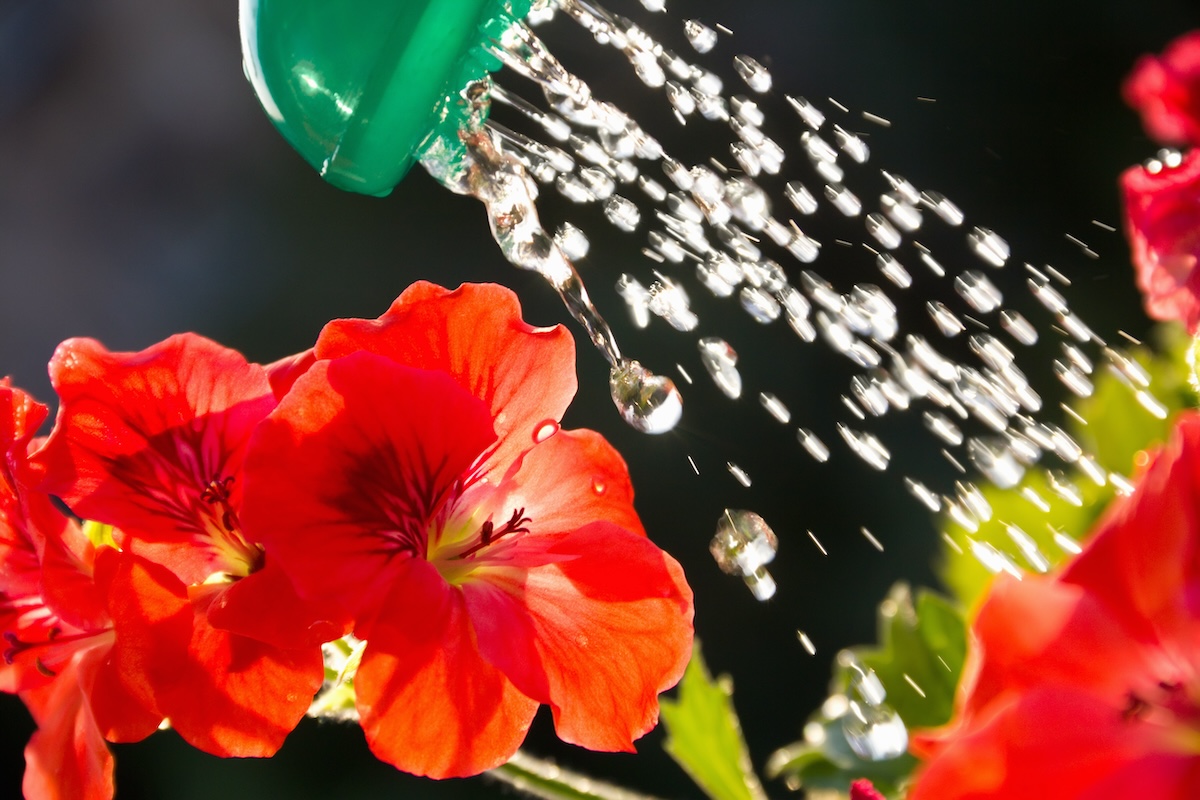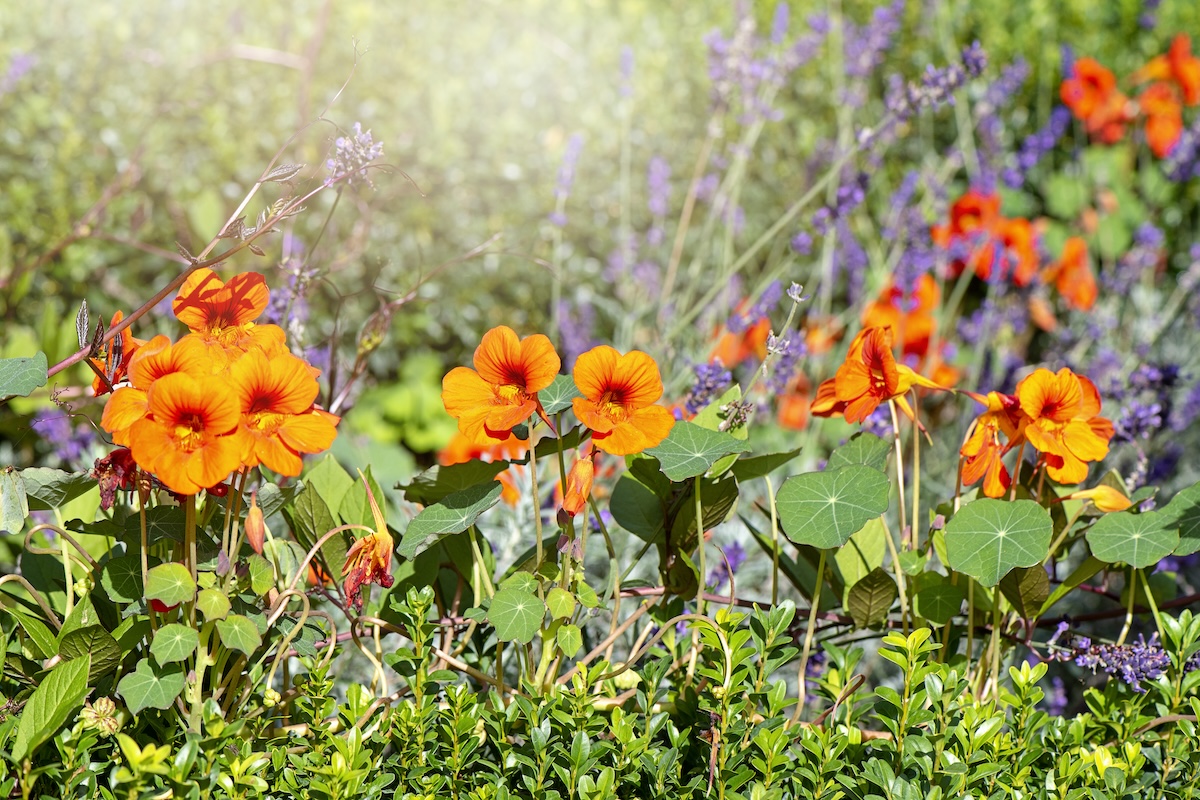

We may earn revenue from the products available on this page and participate in affiliate programs. Learn More ›
Native to mountainous regions of Mexico and South America, nasturtiums have been cultivated in North America since the days of Thomas Jefferson for their peppery edible leaves and their also edible hot-hued flowers. Those flaming colors can be misleading since nasturtiums prefer temperatures on the cool side.
Nasturtiums will grow most vigorously in early summer and autumn. Although there are exotic tuberous tropaeolums that require more fussing, this article on nasturtium care will concentrate on the common garden varieties, easily grown even by rookie gardeners. They thrive on benign neglect, only needing some extra attention during summer heat.
Growing Nasturtium at a Glance
Common Name: Nasturtium
Scientific Name: Tropaeolum majus and Tropaeolum minus
Hardiness Zone: 9 to 11, annual in others
Soil: Poor and sandy
Light: Full sun for better flowering
Water: Medium
Food: None or low-nitrogen fertilizer
Propagation: Seed or stem cuttings
Safety: Edible, but contains oxalic acid
Nasturtium Characteristics

Garden nasturtium plants come in both vining (Tropaeolum majus) and bush or dwarf (Tropaeolum minus) types. The former either climb or cascade—up to 20 feet, according to the Isabella Stewart Gardner Museum, which mounts a display of them every spring. The bushy dwarf types typically don’t surpass 1½ feet in height.
Both varieties produce bright, spurred nasturtium flowers up to 2½ inches in diameter against a backdrop of long-stemmed round leaves. They derive their common name, which means “nose-twister,” from the Latin name of watercress, since their peppery flavor is thought to resemble that of the cress. In fact, nasturtiums were called “Indian cresses” after being transported from the New World to the Old.
Good nasturtium companion plants include beans and members of the cabbage family, since nasturtium can act as a trap species to draw aphids, cabbage worms, and other pests away from those vegetables.
Recommended Nasturtium Varieties
All of these cultivars are mixes that contain flowers in a variety of colors.
- T. majus ‘Alaska’: The plants in this mix grow to 12 inches with snowy white variegation on their leaves.
- T. majus ‘Double Gleam’: This cultivar offers semi-double and double flowers which gleam on plants that can scramble to 60 inches.
- T. majus ‘Phoenix’: Unique due to the fishtail-like points on their flowers’ petals, the nasturtium plants in this mix can rise—or fall—to 72 inches.
Planting Nasturtium

Typically an annual plant, the time to sow the seeds and care of nasturtium can vary by region. Nasturtium plants reportedly can produce blooms as early as 50 days after you sow them.
When is the best time to plant nasturtium?
When starting nasturtium from seed, sow the seeds directly into the garden 1 to 2 weeks before your last spring frost. Alternatively, sow the flower seeds indoors in peat or paper pots 4 to 6 weeks before your last frost and transplant the nasturtium seedlings into the garden after the last frost. Leave them in their biodegradable pots when setting them out, as they resent root disturbance.
Where can nasturtium grow?
In the North, choose a location in fast-draining, preferably sandy soil and full sun. In the South, plant the flowers where they will receive morning sun only. (Alternatively, in frost-free zones, try planting nasturtium in fall for winter bloom, since the plants prefer cool conditions and often will sulk during the hottest weeks of summer even in the North.) For nasturtium companion planting, place the seeds or seedlings near the vegetable plants you wish to protect.
How do you plant nasturtium?
Before seeding nasturtium, sand one side of each seed with an emery board.
- Soak the seeds in water overnight (no longer than 8 hours).
- Sow the seeds ½ to 1 inch deep and 10 inches apart.
- Watch for them to germinate in 7 to 10 days.
Can you grow nasturtium in containers?
When contemplating how to grow nasturtium in pots, consider using hanging baskets for climbing nasturtiums since you can place three to five plants in each basket and allow them to cascade freely. Just be sure that each basket is at least 10 inches deep. If you prefer, you can use large pots equipped with pot obelisks or trellises on which the plants can climb instead of cascade.
Watering Nasturtium

When growing nasturtium, avoid overwatering. According to UC Marin Master Gardeners, nasturtium “prefers moderate, consistent water. However, blooms will actually increase if the plant gets less water.”
Therefore, as with the vegetables that they often accompany, nasturtiums should be able to get by with the typical moderate 1 inch of water a week for plants in the ground. Those in pots, which dry out quickly, may need to be watered more often. Add water when their soil is dry a couple inches beneath the surface.
Fertilizing Nasturtiums
An old saying about “being nasty to nasturtiums” actually means that you shouldn’t overindulge them with too much food, water, or compost since they reportedly bloom best when experiencing benign neglect. Wisconsin Horticulture Extension agrees, advising, “Do not fertilize, except on extremely poor soil, as fertilization will promote leaf growth and suppress flowering.” If you must give nasturtiums fertilizer, avoid high-nitrogen types and opt for the bloom-booster variety instead, following the directions on the package.
Pruning Nasturtium
Nasturtium plants don’t require any pruning, but you might want to snip off the tips if you wish to keep them bushy rather than trailing and pinch off faded flowers to keep them blooming rather than going to seed. The Master Gardeners of Greater Kansas City advise that, “If plants begin to flag in the heat of summer [you should] cut them back and they’ll regrow and flower again when cooler weather arrives in fall.”
Propagating Nasturtiums

You can find instructions for growing nasturtium from seed under “planting” above. The species also can be propagated from cuttings, as some varieties, like the double T. majus ’Hermine Grashoff’, don’t produce seed.
Cut a 4-inch piece from a nasturtium stem, snipping just below a leaf node and removing any lower leaves from the stem—leaving a couple upper ones in place—before putting the cutting in a glass that contains an inch of water. Place the glass on a windowsill where it receives bright, indirect light and keep the water covering at least one leaf node until the cutting roots.
Safety Considerations
Although nasturtium’s foliage and flowers both are edible and nontoxic to pets, you’ll want to avoid the oldest leaves, which can be bitter. Also, keep in mind that this “cress” has parts containing the same oxalic acid present in plants such as spinach and rhubarb, which helps with disease prevention but might be harmful to people with certain health conditions.
According to Colorado State University, “those who experience frequent oxalate kidney stones or have certain genetic and digestive disorders” should consult their physicians before consuming oxalates.
Potential Pests and Diseases
Although nasturtiums generally aren’t prone to disease, they can attract pests such as aphids and cabbage worms, which is what makes them valuable as trap or decoy plants in the vegetable garden. So they don’t always repel bugs, as much as luring them elsewhere.
You can “shoot” aphids off of the plants with a strong stream of water from a spray bottle. Pick larger pests off by hand, while wearing tight-fitting garden gloves, and drop them into a bucket of soapy water to dispose of them.
Looking for more beginner-friendly annual flowers? Check out our guides on growing lantana, marigold, and zinnia.
